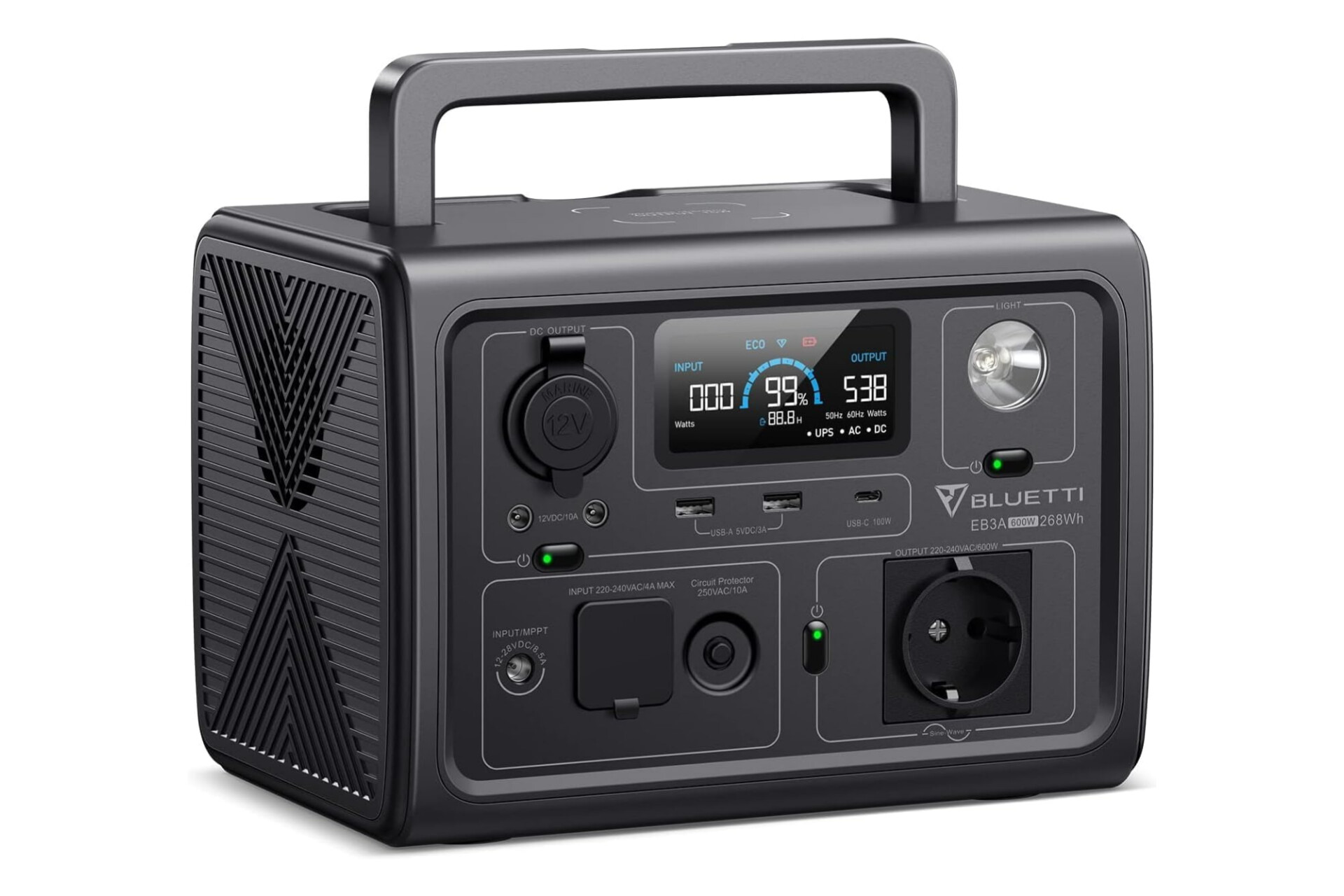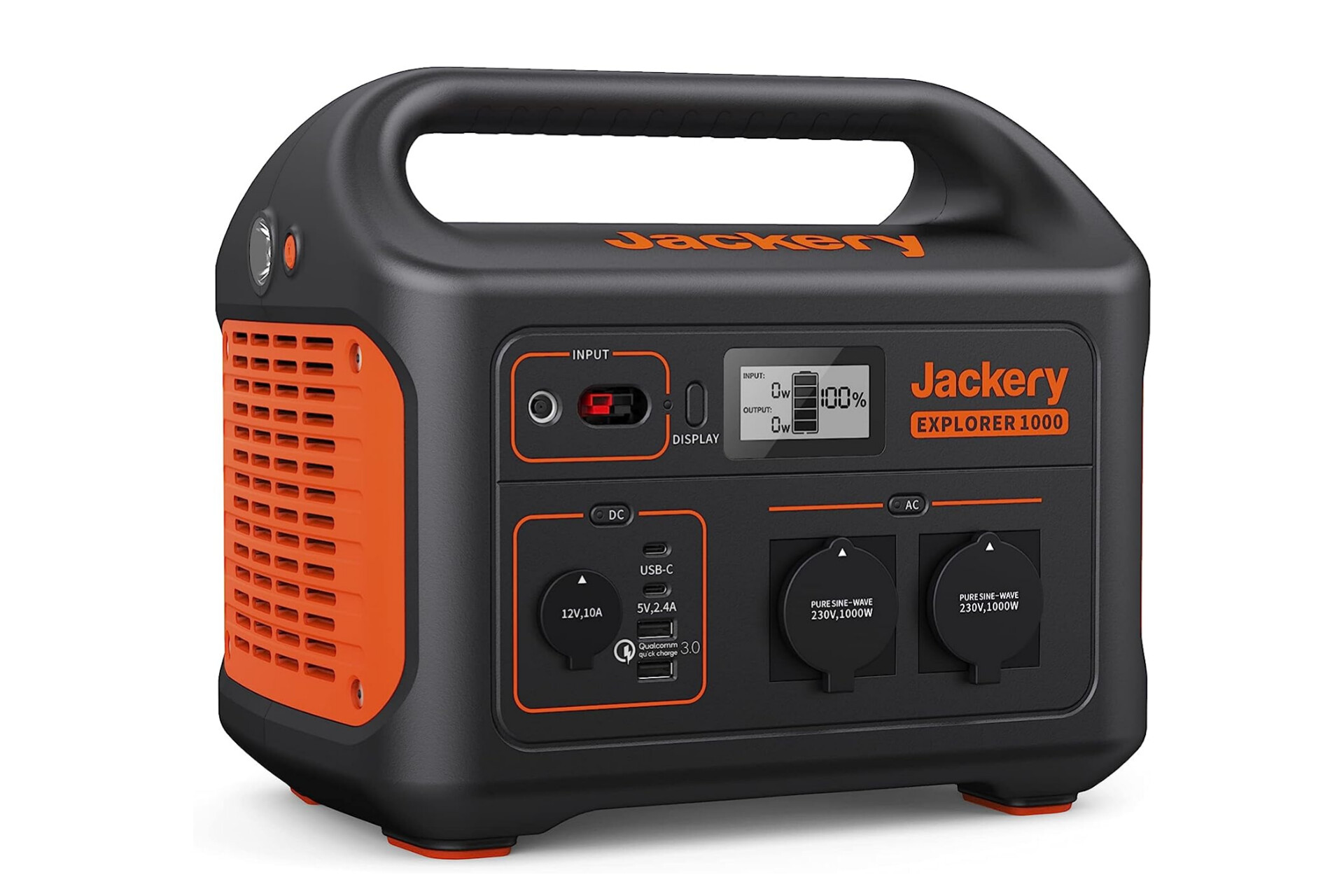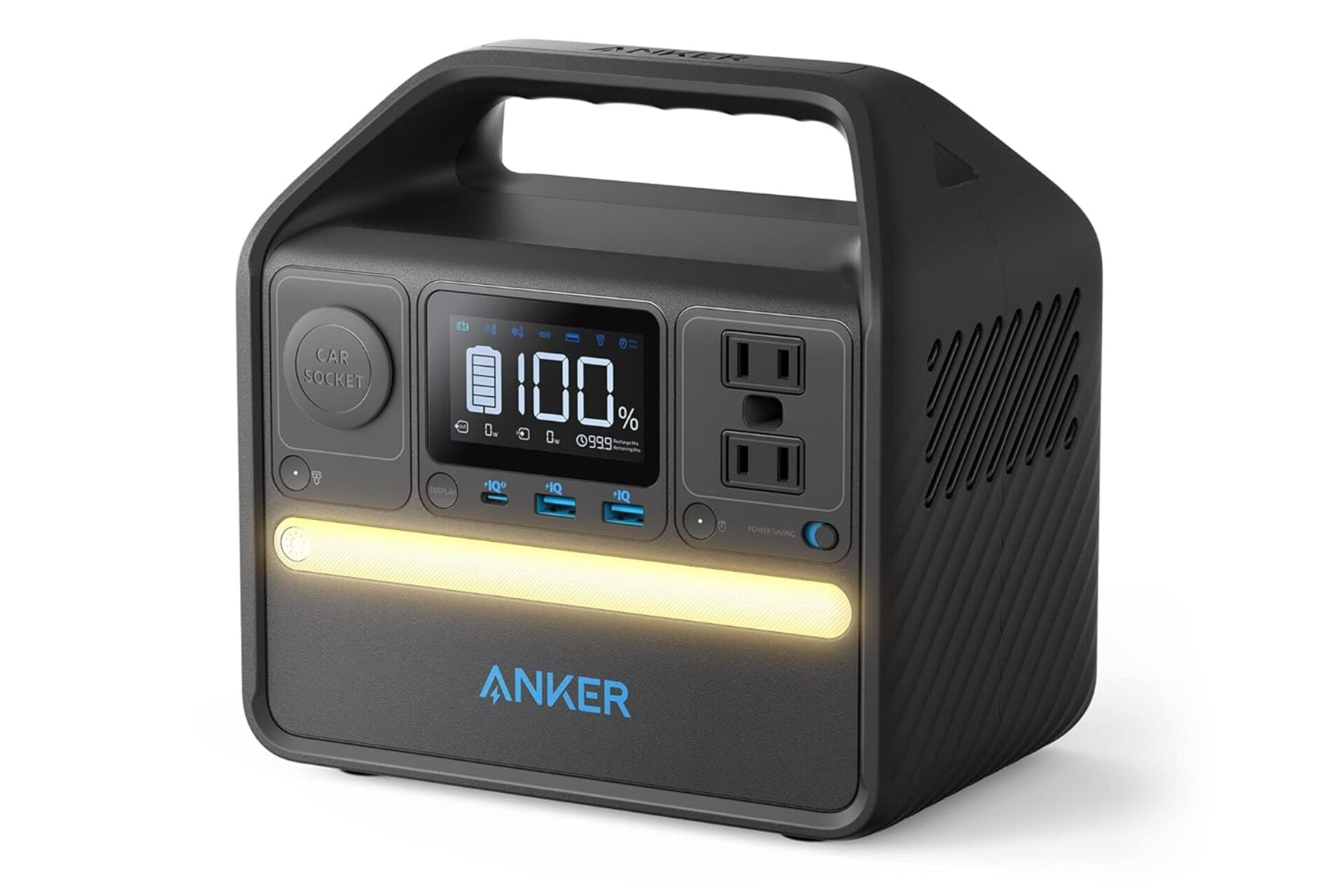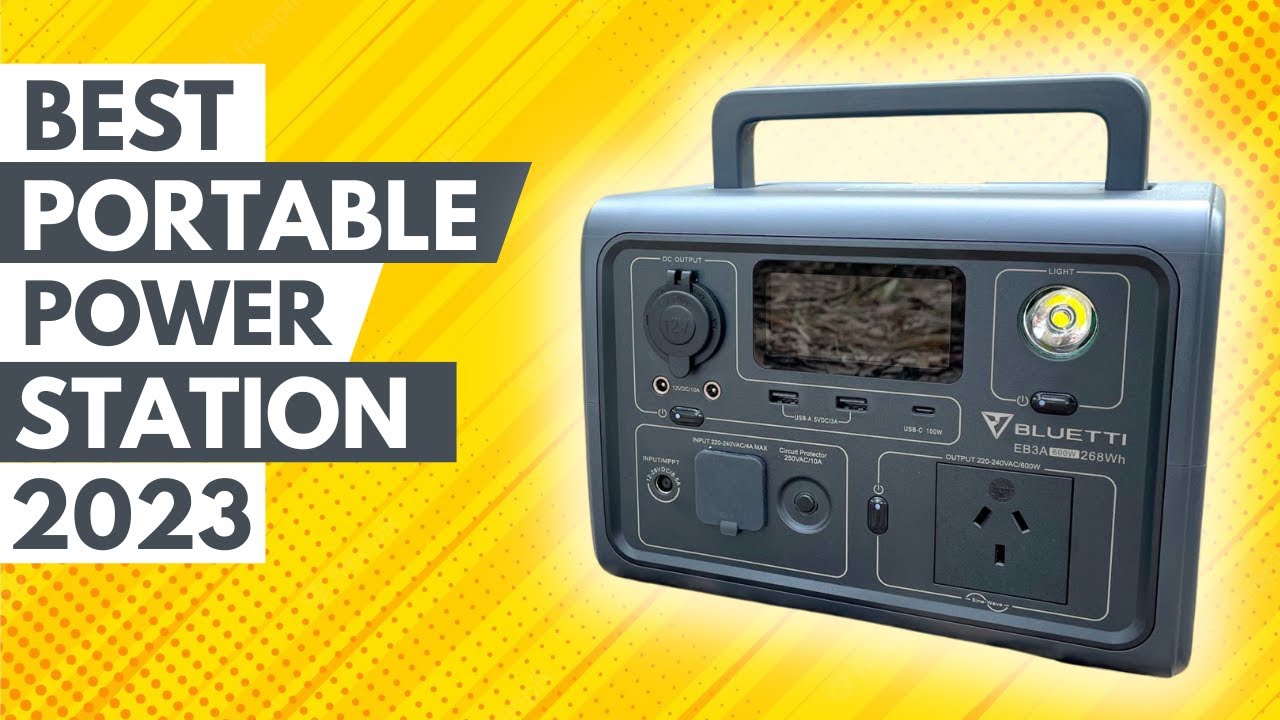Disclaimer: We may earn affiliate commission from qualifying purchases at no extra cost to you.
Welcome to the future of portable energy solutions in 2023! In this guide, we’ll showcase the “5 Best Portable Power Stations,” offering versatile and reliable power sources for your outdoor adventures, emergency situations, and on-the-go power needs. Stay tuned to discover the ultimate portable power stations of the year.

BLUETTI EB3A

EF ECOFLOW DELTA 2

Anker PowerHouse 757

Jackery Explorer 1000

Anker PowerHouse 521

The first one on our list is the Bluetti EB3A Portable power station, The Bluetti EB3A has a 268Wh power capacity in terms of being a power station; that’s a pretty low capacity. The max output of 600W comes as even more of a surprise, but usually, the output would be lower in this case, but it’s higher than what most similar capacity power stations offer.
When it comes to charging devices such as laptops, tablets, or phones, you can still expect many full charges, much more than a regular power bank but less so than power stations with higher capacities. Most phones will be able to charge to full power about 25 times, while laptops and tablets with similar battery sizes can be recharged about 5-6 times with this Bluetti power station. So you’re still looking at days of reliability with the Bluetti EB3A when it comes to solely charging from it.
On the capacity side, when it comes to powering appliances, it’s more about the wattage of the appliances you’re powering. With the EB3A power station having a 268Wh power capacity, you can power a 268W device for 1 hour or a 1W appliance for 268 hours. This is why the 600W output paired with a 268Wh capacity is surprising, as most power stations have both specs in the same range. This isn’t a bad thing, though, this is meant to be a capable and budget power station, but you should know that powering an appliance that requires more than 268W will get you about an hour or less of usage time.
The port selection of the Bluetti EB3A power station is varied, plentiful, and on par with what you can expect from its capacity and output. The unit has one DC cigarette lighter port, two DC 5521 ports, two USB-A ports, one USB-C port, and two AC outlets. Also, it’s not a port, but you also get wireless charging at the top.
The USB-C port can also be used to fast charge most phones at this point, and this is true for Android phones and even iPhones. With iPhones, you’ll have to use a USB-C to Lightning cable, but the fast charging option is still there for most phones.
For a budget power station like this, we thought Bluetti would have settled for a 60W PD port, but a 100W port is surprising and exceeds expectations. In our test were able to charge a Lenovo IdeaPad Flex 5 at its max speed via the USB-C PD port, simultaneously charge a Galaxy Note 9, and Galaxy A51 from the two USB-A ports, and fast wirelessly charge an LG G7 from the 15W wireless charging pad at the top of the power station.
Overall, The EB3A is a solid entry into the market by Bluetti with its unique combination of capacity, power delivery capability, and battery technology.

The next one on our list is EF Eco-Flow Delta 2 Portable Power Station, The EcoFlow DELTA 2 portable power station is a highly capable and powerful solution for those who need reliable backup power on the go. With a battery capacity of 1024Wh and peak inverter output of up to 1800W, the DELTA 2 can power a variety of IT hardware and small clusters for a period of time. One of the biggest changes though for the 2nd generation DELTA series is the move to LiFePO4 battery technology, which has a much longer lifespan than prior chemistries.
The DELTA 2 can be charged in a variety of ways, including AC charging at 1200W, solar charging at up to 500W and car charging at up to 8A. It also supports DC charging at 1100W through EcoFlow’s Smart Generator. Another standout feature of the DELTA 2 is its ability to support an extra DELTA 2 or DELTA Max battery, allowing users to extend its runtime even further. This enables longer backup capabilities as an emergency power supply in case of grid outages or unstable power service. With its ability to auto-switch to battery power, the DELTA 2 allows devices will continue to run during inclement weather or other emergency situations.
In terms of charging capabilities, the EcoFlow DELTA 2 does it right with onboard AC chargers. It keeps miscellaneous accessories to a minimum when you are bringing hardware with you in the field and also has advantages for charging speed. The DELTA 2 can draw 1200W from the wall, which minimizes the time needed to recharge. It also uses the standard C13 power plug which is one used commonly with computer hardware, versus a proprietary connector. The advantage here is if you lose the cable that shipped with the unit, you can just share it with another device that uses the same connection.
In terms of power capabilities, the DELTA 2 has a wide range of AC output options, with six outlets that can handle up to 1800W of power. This means it can power multiple devices at once, including high-powered devices like servers, workstations, or power tools. Plus, with the X-Boost function, users can boost the power output up to 2200W to support even more demanding devices.
In addition to its AC output, the DELTA 2 also supports charging USB-connected hardware. There are two standard USB-A ports, as well as two USB-A Fast Charge ports that support faster charging speeds for compatible devices. There are two USB-C ports with a maximum output of 100W to charge notebooks without needing to activate the AC power inverter.
Overall, The Ecoflow Delta is one of the must-haves when it comes to the emergency power station. It provides lots of power for a long period of time and can power many devices, appliances, and apparently an EV.

The third one on our list is the Anker Powerhouse 757 Portable Power Station, The Anker 757 PowerHouse has one of the most elegant designs we’ve yet seen in a power station. All of the controls and outlets live on the front of the unit. You also get a nice LED bar-style light across the top that emits enough light to let you see around a campsite—or even a job-site table to read building plans.
The 757 PowerHouse Power Station has convenient handles that line up well for deadlifting this giant battery. The only problem is that you can only deadlift it as there are no wheels to assist you in moving this 44-pound device from place to place. All of that weight signifies something important, however. The Anker 757 Power Station doesn’t achieve its 1500W rating on its good looks. It also features 1,229Wh of battery capacity. While not the largest power center we’ve tested or seen, that still represents a good amount of stored energy.
Internally, Anker seems to have built the Powerhouse 757 to handle being run over by a truck. It has an aluminum frame that surrounds the electronics and 1229Wh worth of LFP (LiFePO4) cell batteries. We connected a 15A DeWalt shop vac to the Anker 757. It draws around 1200 Watts and runs for exactly 54 minutes and 43 seconds. Based on the estimates given by Anker, that actually beat their number by 14%. We would consider that a win.
When testing with tools that stay under 1500W, the Anker supplied enough power to keep them going. As a temporary power source for medium-duty tools, you should be able to get some use out of this product. The higher the load, however, the less runtime you receive.
The Anker 757 PowerHouse recharges quite quickly for a power station this large. We connected it to a 20A circuit, and the PowerHouse 757 reached a 100% charge in one hour and thirty-two minutes. While we would have liked to have seen if it got to 80% in an hour as claimed—the truth is, the LCD display is highly inaccurate while charging. Right before the unit hit 100% it was showing 1.8 hours on the meter, a charge rate of ~300W, and 61% completion. 10 seconds later it hit 100% and stopped charging.
Overall, Anker’s new 757 goes beyond your regular power station by having a built-in fast charger, high-endurance batteries, and a UPS mode. It is particularly well suited in an office as it is relatively quiet and easy on the eye.

The next one on our list is the Jackery Explorer 1000 Portable Power Station, The Jackery Solar generator is a 1000W portable power station with a 1002 Wh capacity. It has three pure sine wave AC outlets, 2 USB-C ports, 1 USB-A port that supports Quick Charge 3.0, and one DC power port. In short, you can plug basically anything into this bad boy, from a phone to a refrigerator, and it will run just fine. All the power ports are located on the front, along with an LCD display that shows you the current charge level, incoming power, and outgoing power. Both AC and DC sections have power buttons, so you can turn them off when not in use. Around the side is a single flashlight with its own power button, and on the left is a large vent that accommodates airflow for the fans inside.
Along with the Explorer 1000, you can purchase two SolarSaga 100 solar panels that recharge the Explorer. The cells run at 23% efficiency, which is pretty decent in the field. They can generate up to 100W of peak power on a bright sunny day. Each of those panels weighs in at just over 10 pounds apiece. The Explorer 1000 battery weighs over 22 pounds. The panels fold up into 24 by 21 by 1.4 inches; put simply, none of this package is very portable or small.
We used the Jackery to power a couple of different portable setups for work. In one instance, we used it for a Windows laptop, school Chromebook, iPad, Android phone, and wireless headphones for two and a half days.
Using the battery is very straightforward. Just plug in what you need to power and turn on the outlets you need. You turn them on in groups — AC and DC. While you’re working, you will notice when the fan kicks on, because it’s fairly loud. It’s not jet-engine loud, but it can cover up a soft-spoken person for sure. Really, the fan is our only complaint about the device. It’s really noticeable.
When it came time to recharge, I tried two different methods. First, I plugged the Explorer 1000 into the wall. That took around eight hours to charge back to full. That’s not too bad. Next, I busted out the two solar panels, and that’s where the fun began. Overall, this is a great power generator/battery that does exactly what it promises.

The last one on our list is the Anker Powerhouse 521 Portable Power Station, The Anker 521 power station is an entry-level portable power carrying five outlets: one car socket, one three-pin UK socket, one fast-charging USB-C, and two fast-charging USB-A. The 521 also has a lamp bar on its front and boasts a Power Saving mode which automatically cuts power to a device once fully charged, preventing the station from needlessly pumping out power.
At 256Wh, the Anker 521 can recharge handheld devices, laptops, cameras, and drones. It will power anything rated up to 200w, such as fans or a mini-fridge. It must not be used with appliances with heavy power needs like refrigerators, microwaves, or hair dryers. What stands out about this portable power generator is its ability to store energy longer. Its LiFePO4 battery has a six times longer lifespan than an ordinary power station. The battery capacity of 3000 cycles makes the solar generator a masterpiece. A suitable power generator must also be portable.
This specific model of portable solar generator by Anker weighs 45.6 pounds or 20.7 kg. Unlike other solar generators weighing tons, the 521 portable power station is easy to work and walk around with. The Solar Generator is also compatible with almost all your important devices. Anker 521 rechargeable power set includes a DC adapter and a car cable. The cable can be plugged into a car power output or AC outlet.
The solar generator is perfect for keeping your devices charged when there is a power outage or in an off-grid setting. If you are a photographer, this speaks volumes. It is zero-noise and lets you capture photo shoots like a pro. The 521 portable power station also features a smart LED display. It is an important addition that lets you monitor your energy status.
Overall, A reliable energy supply means a lot in a world where we depend so much on information. With Anker 521 Portable Power Station, you will never lose business or miss deadlines due to power outages. And if you work outdoors most of the time, you have every reason to grab this generator set.
In a world increasingly reliant on electronic devices, having a reliable source of portable power is essential. Whether you’re camping, preparing for emergencies, or simply need a portable power solution for outdoor activities, a portable power station can be a game-changer. In this buying guide, we’ll help you navigate the options and choose the best portable power station for your needs in 2023.
What is a Portable Power Station?
A portable power station, also known as a portable generator or power bank, is a compact and lightweight device designed to store electrical energy and provide multiple outlets for charging or powering various devices. These versatile units come in a range of sizes and capacities, making them suitable for various applications.
Considerations when Buying a Portable Power Station:
1. Capacity (Watt-hours):
The capacity of a power station determines how much energy it can store and supply. Consider the watt-hour (Wh) rating to gauge a unit’s capacity. The higher the Wh rating, the more devices you can charge or power, and the longer the power station will last. Assess your needs and choose a capacity that aligns with your requirements.
2. Portability:
Portability is a key factor for most users. Look for a power station that is lightweight, has carrying handles, and may even come with wheels for easy transportation. The size and weight of the unit should be manageable for your intended use, whether it’s for camping trips, RVing, or backup power.
3. Battery Type:
Most portable power stations use one of two types of batteries: lithium-ion (Li-ion) or lead-acid. Li-ion batteries are lighter, more efficient, and have a longer lifespan, making them a popular choice. Lead-acid batteries, while heavier, are often more affordable. Consider which battery type aligns with your priorities for weight, cost, and performance.
4. Charging and Output Ports:
Check the types and number of output ports the power station offers. Common ports include AC outlets, USB ports, DC outlets, and even wireless charging. Ensure the power station has the appropriate ports for your devices, such as laptops, smartphones, and camping equipment.
5. Inverter:
If you plan to power sensitive electronic devices, look for a power station with a pure sine wave inverter. This type of inverter provides clean and stable power, preventing damage to your electronics.
6. Recharging Options:
Consider how you’ll recharge the power station. Most models offer multiple recharging methods, such as solar panels, wall outlets, and car chargers. Solar compatibility can be a significant advantage for outdoor enthusiasts.
7. Display and Monitoring:
Some power stations come with digital displays or mobile apps that allow you to monitor battery status, input/output power, and more. These features can help you manage your power station efficiently.
8. Durability and Weather Resistance:
For outdoor use, prioritize models that are built to withstand various weather conditions. Look for power stations with durable casing and, if possible, an IP rating indicating water and dust resistance.
9. Safety Features:
Safety is paramount. Choose a power station with protection mechanisms like overcurrent protection, short-circuit protection, and temperature control to prevent damage to the unit and connected devices.
Conclusion:
When choosing the best portable power station for your needs in 2023, carefully assess your power requirements, portability preferences, and budget constraints. The options listed above are among the best in the market, but make sure to compare them based on your specific needs to find the ideal portable power solution for you. A reliable portable power station can provide peace of mind and convenience in various situations, ensuring you stay connected and powered up wherever you go.

